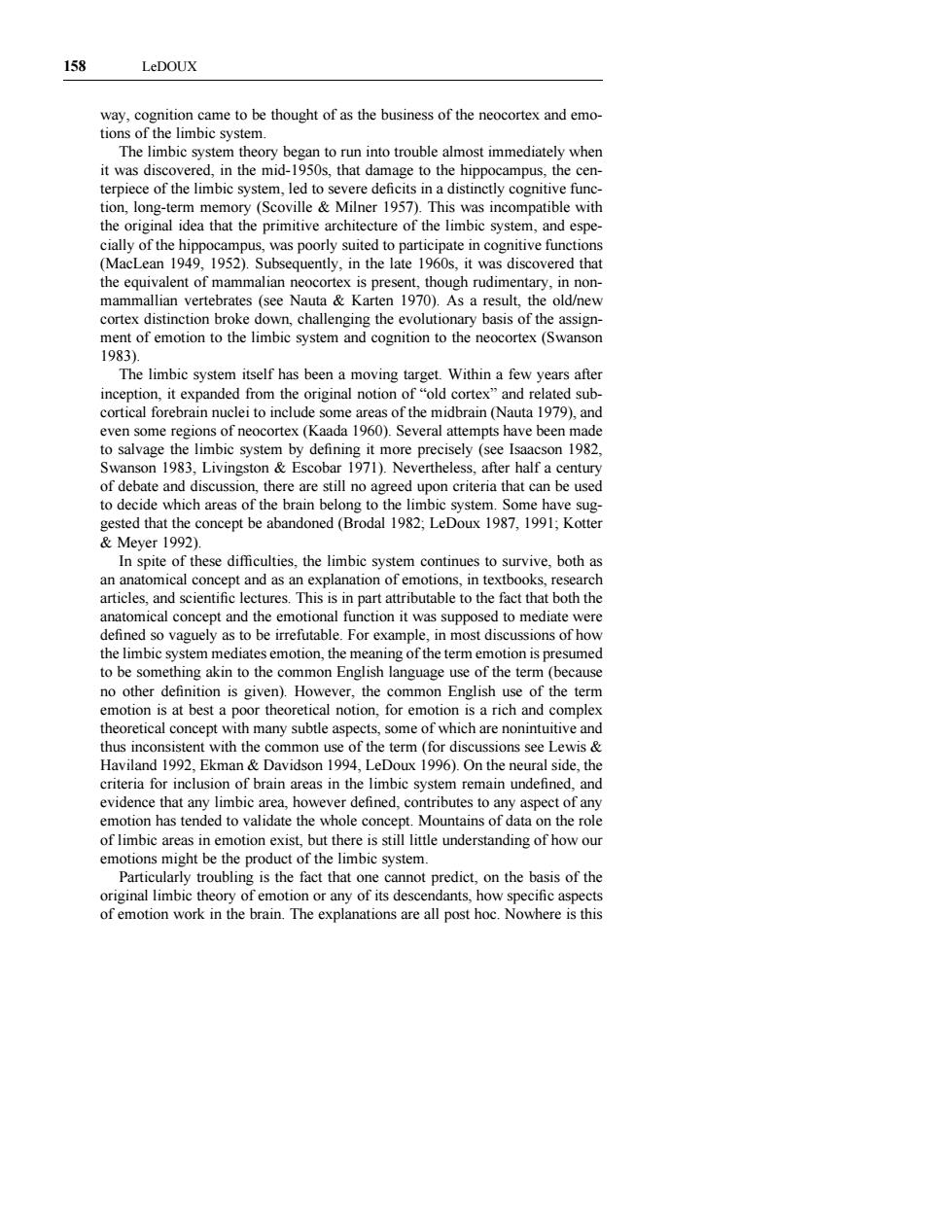正在加载图片...

158 LeDOUX way,cognition came to be thought of as the business of the neocortex and emo- tions of the limbic system. when it y terpiece of the limbic system,led to severe func tion,long-term memory (Scoville Milner 1957).This was incompatible with idea that the primitive architecture of the limbic system sowo网可 d that the equivalent of mammalian neocortex is present,though rudimentary,in non- mammalanion As a result,the old/new ging the evo 1983 The limbic system itself has been a moving target.Within a few years after inception,it expande trom the original notion c old cortex and related sub me re ortey (Kaada 1960)S ts have be to salvage the limbic system by defining it more precisely (see Isaacson 1982, nson 1983,Livingston&Escobar 1971).Nevertheless,after half a century no agreed on critena th t can be use gested that the concept be abandoned (Brodal 1982:LeDoux Kotter &Meyer 1992). spite of the limbic system ontinu s to survive,both as ures This is ir ble to th e fact that both the anatomical concept and the emotional function it was supposed to mediate were c system m no other definition is given).However,the common English use of the term emotion is at best a poor theoretical notion,for emotion is a rich and complex etical conceptw many subtle aspects,some c ch are nonintuitive Haviland 1992 Ekman Davidson 1994 LeDoux 199 On the newral side the criteria for inclusion of brain areas in the limbic system remain undefined,and as tended to val e conce of the emotions might be the product of the limbic system Particularly troubling is the fact that one cannot predict,on the basis of the n or any of its descer e explanations are all pos158 LeDOUX way, cognition came to be thought of as the business of the neocortex and emotions of the limbic system. The limbic system theory began to run into trouble almost immediately when it was discovered, in the mid-1950s, that damage to the hippocampus, the centerpiece of the limbic system, led to severe deficits in a distinctly cognitive function, long-term memory (Scoville & Milner 1957). This was incompatible with the original idea that the primitive architecture of the limbic system, and especially of the hippocampus, was poorly suited to participate in cognitive functions (MacLean 1949, 1952). Subsequently, in the late 1960s, it was discovered that the equivalent of mammalian neocortex is present, though rudimentary, in nonmammallian vertebrates (see Nauta & Karten 1970). As a result, the old/new cortex distinction broke down, challenging the evolutionary basis of the assignment of emotion to the limbic system and cognition to the neocortex (Swanson 1983). The limbic system itself has been a moving target. Within a few years after inception, it expanded from the original notion of “old cortex” and related subcortical forebrain nuclei to include some areas of the midbrain (Nauta 1979), and even some regions of neocortex (Kaada 1960). Several attempts have been made to salvage the limbic system by defining it more precisely (see Isaacson 1982, Swanson 1983, Livingston & Escobar 1971). Nevertheless, after half a century of debate and discussion, there are still no agreed upon criteria that can be used to decide which areas of the brain belong to the limbic system. Some have suggested that the concept be abandoned (Brodal 1982; LeDoux 1987, 1991; Kotter & Meyer 1992). In spite of these difficulties, the limbic system continues to survive, both as an anatomical concept and as an explanation of emotions, in textbooks, research articles, and scientific lectures. This is in part attributable to the fact that both the anatomical concept and the emotional function it was supposed to mediate were defined so vaguely as to be irrefutable. For example, in most discussions of how the limbic system mediates emotion, the meaning of the term emotion is presumed to be something akin to the common English language use of the term (because no other definition is given). However, the common English use of the term emotion is at best a poor theoretical notion, for emotion is a rich and complex theoretical concept with many subtle aspects, some of which are nonintuitive and thus inconsistent with the common use of the term (for discussions see Lewis & Haviland 1992, Ekman & Davidson 1994, LeDoux 1996). On the neural side, the criteria for inclusion of brain areas in the limbic system remain undefined, and evidence that any limbic area, however defined, contributes to any aspect of any emotion has tended to validate the whole concept. Mountains of data on the role of limbic areas in emotion exist, but there is still little understanding of how our emotions might be the product of the limbic system. Particularly troubling is the fact that one cannot predict, on the basis of the original limbic theory of emotion or any of its descendants, how specific aspects of emotion work in the brain. The explanations are all post hoc. Nowhere is this